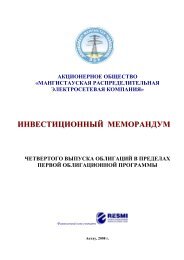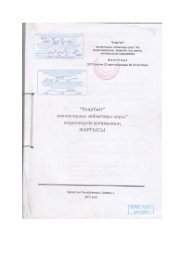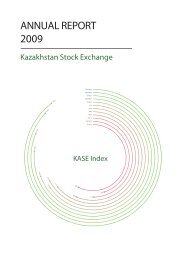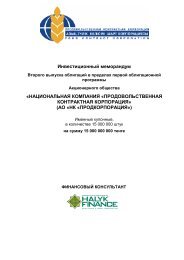Download
Download
Download
Create successful ePaper yourself
Turn your PDF publications into a flip-book with our unique Google optimized e-Paper software.
The Kashaghan field was one of the largest discoveries in the<br />
world over the past 40 years and also the largest offshore<br />
discovery. The field is located in the Kazakhstan sector of<br />
the Caspian Sea and occupies an area of approximately<br />
75x45 km. The reservoir is situated about 4,200 metres<br />
below the seabed in the northern part of the Caspian Sea.<br />
The development of the Kashaghan field in the harsh maritime<br />
conditions of the northern Caspian represents a unique<br />
combination of technological complexities and supply chain<br />
difficulties. These complexities are related to the provision of<br />
a safe working environment and the resolution of technical<br />
engineering, logistical and ecological tasks, which make<br />
Kashagan one of the largest and most complex energy projects<br />
in the world.<br />
The Tengiz is a giant oil field, related to the Pre-Caspian oil and<br />
gas province of the north Caspian Sea. The oil reservoir lies at a<br />
depth of about 4,000 metres. The Tengiz reservoir is 19 km<br />
long, and 21 km wide, and is 1.6 km high. Total discovered<br />
reserves in drilled and undrilled areas of the Tengiz reservoir are<br />
estimated at around 3.1 billion tonnes or 26 billion barrels.<br />
Another promising area from the point of view of oil and gas<br />
potential is the Aktobe region. About 25 fields have been<br />
identified here. The most significant geological discoveries<br />
in this region are the Zhanazhol group of fields with extractable<br />
reserves of oil and condensate of 170 million tonnes. In 2005<br />
an announcement was made for a discovery in the central<br />
block of the eastern part of the Caspian depression of the new<br />
Umit field.<br />
The base of the oil production industry of Kyzylorda and<br />
Karaganda regions is the Kumkol group of fields – the fifth most<br />
important oil and gas province of Kazakhstan. In the summer<br />
of 2005, PetroKazakhstan, the oil company operating in this<br />
region, announced the finding of commercial oil reserves in the<br />
licensed territory of Kolzhan, which lies next to the northern<br />
perimeter of the Kyzylkia field.<br />
Key indicators<br />
According to data provided by the Ministry of Oil and Gas<br />
of the Republic of Kazakhstan, confirmed reserves of<br />
hydrocarbons on shore and on the sea shelf are estimated<br />
at 4.8 billion tonnes or over 35 billion barrels. For comparison,<br />
in 2001 the explored balance reserves of oil were only<br />
2.9 billion tonnes. Moreover, the forecast oil reserves in the<br />
Kazakhstan sector of the Caspian Sea alone may exceed<br />
17 billion tonnes or 124 billion barrels, according to some<br />
experts. Taking into account both the reserves of oil and<br />
gas and constantly growing production, in the foreseeable<br />
future, Kazakhstan will continue to be at the center of world oil<br />
production.<br />
According to information from the Ministry of Oil and Gas,<br />
production of oil and gas condensate in 2012 amounted<br />
to 79.2 million tonnes. This compares with oil production of<br />
only 25.9 million tonnes in 1998. Kazakhstan is also one of<br />
the top gas producers of the CIS member-states, producing<br />
40.1 billion cubic metres in 2012.<br />
In 2012, Kazakhstan’s oil and gas-processing plants refined<br />
14.2 million tonnes of crude oil and produced 2.2 thousand<br />
tonnes of LPG. Domestic consumption of natural gas last year<br />
was 10.5 billion cubic metres.<br />
Kazakhstan exports the bulk of its produced oil via pipelines.<br />
In 2012 the volume of oil exported was 68.6 million tonnes, of<br />
which 15.4 million tonnes were exporetd through the “Atyrau–<br />
Samara” pipeline and, 27.9 million tonnes through the Caspian<br />
Pipeline Consortium (CPC) line. A further 10.4 million tonnes<br />
was exported to China through the “Atasu–Alashankou” line.<br />
The value of crude oil exports amounted to the equivalent of<br />
US$ 56.4 billion, which is 60 % of Kazakhstan’s total exports.<br />
The volume of gas exports from Kazakhstan in 2012 were<br />
8.8 billion cubic metres. Meanwhile, the volume of international<br />
gas transit across the territory of the Kazakhstan last year was<br />
96.5 billion cubic metres.<br />
In the future, the volume of production of oil and gas<br />
in Kazakhstan will have a tendency to a significant increase.<br />
The increase is connected to three main factors, these are<br />
the significant growth in capital investment, the expected<br />
growth in demand on international markets for hydrocarbons<br />
and the fruits of intensive exploration and development work<br />
in the hydrocarbon basins of both the Caspian and Aral seas.<br />
All these factors will support further growth of the resource<br />
potential of this key economic sector.<br />
7

















